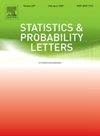Space–time fractional diffusion with stochastic resetting
IF 0.7
4区 数学
Q3 STATISTICS & PROBABILITY
引用次数: 0
Abstract
In this article, we study the space–time fractional diffusion equation (STFDE) which is a generalization of the classical diffusion equation, in the presence of stochastic resetting. The STFDE is formulated by replacing the standard time and space derivatives with the Caputo and Riesz fractional derivatives, respectively, to capture anomalous diffusion behaviors. We derive analytical solutions using Laplace and Fourier transforms, and express them in terms of Fox H-functions. We obtain a closed-form expression for the stationary distribution and prove the finiteness of the mean first passage time. Additionally, we examine how stochastic resetting influences the infinite divisibility of the standard diffusion process, showing that this property is lost once resetting is introduced. The reset mechanism interrupts the Lévy process at random times, effectively altering the jump structure and destroying the self-decomposability required for infinite divisibility.
随机重置的时空分数扩散
本文研究了随机重置条件下的时空分数扩散方程(STFDE),它是经典扩散方程的推广。STFDE是通过分别用Caputo和Riesz分数阶导数代替标准时间和空间导数来制定的,以捕获异常扩散行为。我们用拉普拉斯变换和傅里叶变换推导出解析解,并用Fox h函数表示它们。得到了平稳分布的封闭表达式,并证明了平均首次通过时间的有限性。此外,我们研究了随机重置如何影响标准扩散过程的无限可分性,表明一旦引入重置,这种性质就会丢失。复位机制在随机时间中断lsamvy过程,有效地改变了跳跃结构,破坏了无限可整除性所需的自分解性。
本文章由计算机程序翻译,如有差异,请以英文原文为准。
求助全文
约1分钟内获得全文
求助全文
来源期刊

Statistics & Probability Letters
数学-统计学与概率论
CiteScore
1.60
自引率
0.00%
发文量
173
审稿时长
6 months
期刊介绍:
Statistics & Probability Letters adopts a novel and highly innovative approach to the publication of research findings in statistics and probability. It features concise articles, rapid publication and broad coverage of the statistics and probability literature.
Statistics & Probability Letters is a refereed journal. Articles will be limited to six journal pages (13 double-space typed pages) including references and figures. Apart from the six-page limitation, originality, quality and clarity will be the criteria for choosing the material to be published in Statistics & Probability Letters. Every attempt will be made to provide the first review of a submitted manuscript within three months of submission.
The proliferation of literature and long publication delays have made it difficult for researchers and practitioners to keep up with new developments outside of, or even within, their specialization. The aim of Statistics & Probability Letters is to help to alleviate this problem. Concise communications (letters) allow readers to quickly and easily digest large amounts of material and to stay up-to-date with developments in all areas of statistics and probability.
The mainstream of Letters will focus on new statistical methods, theoretical results, and innovative applications of statistics and probability to other scientific disciplines. Key results and central ideas must be presented in a clear and concise manner. These results may be part of a larger study that the author will submit at a later time as a full length paper to SPL or to another journal. Theory and methodology may be published with proofs omitted, or only sketched, but only if sufficient support material is provided so that the findings can be verified. Empirical and computational results that are of significant value will be published.
 求助内容:
求助内容: 应助结果提醒方式:
应助结果提醒方式:


